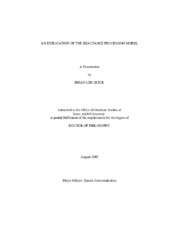| dc.description.abstract | The present dissertation applied the theoretical assumptions of Psychological
Reactance Theory into a model depicting how individuals cognitively process reactanceinducing
print messages utilizing a communication framework, the Reactance
Processing Model (RPM). Specifically, the RPM conceptualizes reactance as a
motivational state, investigates the degree of reactance arousal elicited by threat-tochoice,
vivid, and explicit language (along with an additive effect of the aforementioned
message features), empirically measures reactance restoration, and explores the role of
issue involvement on message processing of reactance-inducing print messages
advocating exercise and sunscreen usage by college students (N = 550). The RPM was
tested using an experimental 2 (implicit vs. explicit) X 2 (non-vivid vs. vivid) X 2 (lowthreat-
to-choice language vs. high-threat-to-choice language) posttest only design.
Four general conclusions are drawn from this investigation. First, results support
operationalizing reactance as a latent construct comprised of unfavorable cognitions and
state anger. Second, of the three message features examined, high threat-to-choice and
vivid language, along with a combination of both were found to elicit reactance.
Explicit language did not trigger reactance in this study. Third, perceived high threat-tochoice
language was positively associated with reactance whereas perceived vivid and explicit language was either negatively or not associated with reactance. Fourth,
reactance was positively related to three types of restoration including ??Boomerang,??
??Related Boomerang,?? and ??Vicarious Boomerang.?? Specifically, ??Boomerang??
restoration appears to be triggered regardless of threat attractiveness whereas ??Related
Boomerang?? and ??Vicarious Boomerang?? require an attractive threat before being set
into motion. Results from this investigation along with the limitations and heuristic
value of the RPM are provided. | en |


